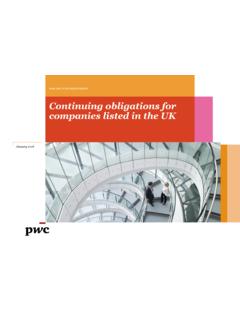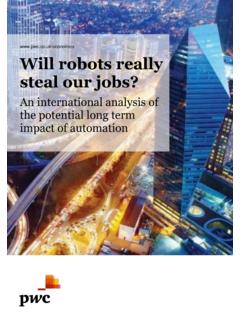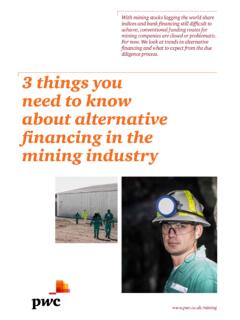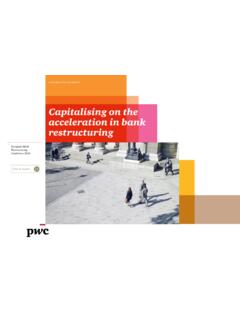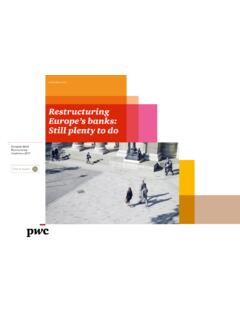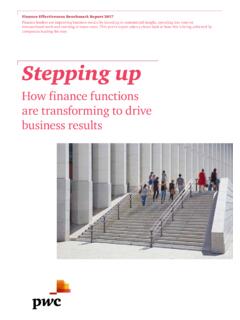Transcription of Highlights and key messages - pwc.co.uk
1 3UK Economic Outlook March 2018 Highlights and key messages for business and public policyRecent UK developments and prospects UK economic growth slowed in 2017 as inflation rose sharply, squeezing household spending power. In our main scenario, we project UK growth to remain modest at around in 2018 and in 2019. This is due to continued subdued real consumer spending growth and the drag on business investment from ongoing economic and political uncertainty relating to the outcome of the Brexit negotiations. The stronger global and Eurozone economies, and the competitive value of the pound particularly against the euro, should also boost exports, however, which will offer some support for overall UK GDP growth.
2 Service sector growth should remain modest but positive in 2018-19, while manufacturing retains momentum after ending 2017 strongly. But the construction sector has fallen back due to the weakness of commercial property investment and this looks set to continue this year. The Bank of England could raise interest rates once or twice this year, though the pace of increase will remain limited and are the longer term prospects for consumer spending? We project households will spend over 30% of their budget on housing and utilities by 2030, up from around 27% in 2017. Spending on financial services and personal care will also tend to increase relatively rapidly over time, while the share of total spending on food and clothing will tend to decline in the long run.
3 Automation could have a major impact on retail jobs in the long run, but will also bring benefits to consumers in lower prices. This will allow consumers to increase their real spending levels, potentially creating new jobs in less automatable services sectors such as health and personal care. Emerging technologies like artificial intelligence (AI) could also bring great competitive advantage to businesses that deploy them trends and prospects London has grown significantly faster than other UK regions for most of the past two decades, but recently there have been signs from both the labour and housing markets that London s relative performance has been less strong.
4 We expect this to continue in 2018-19, with London growing at close to the UK average rate. As manufacturing has bounced back recently on the back of a stronger global economy and a more competitive value of the pound, this has helped parts of the UK with stronger industrial bases in the North and the projections20182019 Real GDP spending (CPI) : PwC main scenario projections4 1 SummaryRecent developmentsThe UK economy held up well in the six months after the EU referendum, but growth slowed markedly from early 2017 as consumer spending growth key factor behind that moderation was the increase in the rate of consumer price inflation (CPI) from around zero on average in 2015 to 3% in the year to January 2018, as global commodity prices have picked up from lows in early 2016, and the effects of the weak pound after the Brexit vote have fed through supply chains.
5 Higher inflation has squeezed real household incomes and this has taken the edge off consumer-led growth. Brexit-related uncertainty has also dampened business investment the more positive side, UK exports have been boosted by the upturn in global growth over the past year, notably in the Eurozone. The weaker pound, although bad for UK consumers, has been helpful to exporters and inbound : Summary of UK economic growth and inflation prospectsIndicator (% change on previous year)OBR forecasts (March 2018)Independent forecasts (February 2018)PwC Main scenario (March 2018) (CPI) : Office for Budget Responsibility (March 2018), HM Treasury survey of independent forecasters (average value of new forecasts made in February 2018 survey) and latest PwC main prospectsAs shown in Table , our main scenario is for UK GDP growth to remain moderate at around in 2018 and in 2019.
6 Our views on growth and inflation are broadly similar to the latest consensus and OBR forecasts (see Table ). Consumer spending growth is expected to moderate to only around 1% in 2018 but may pick up slightly next year as real wages recover. Longer term trends and prospects for consumer spending are discussed further the positive side, the stronger global economy should continue to have some offsetting benefits for net exports (though there are downside risks here if recent US tariff policy changes were to lead to a wider trade war). Brexit-related uncertainty may continue to hold back business investment, but this should be partly offset by planned increases in public investment and some easing of austerity over the next two years as announced in the November 2017 are always uncertainties surrounding our growth projections, as illustrated by the alternative scenarios in Figure There are still considerable downside risks relating to possible pitfalls on the road to Brexit, but there are also upside possibilities if these problems can be contained and global growth continues to pick up.
7 In our main scenario, we expect the UK to continue with moderate but steady growth in 2018-19, but businesses need to monitor and make contingency plans for potential alternative scenarios related to Brexit and other should fall back gradually over the course of 2018 and 2019 assuming no major shifts in exchange rates or global commodity prices. Given continued uncertainties around Brexit, we expect the Monetary Policy Committee to be cautious about the pace of future interest rate rises, but one or two increases seem possible this Economic Outlook March 2018 Longer term outlook for consumer spending and the impact of automationAs shown in Table , we expect consumer spending growth to slow to only around 1% this year and pick up only modestly to around in 2019, but in the longer term it should return to an estimated trend rate of around 2% per annum on average in the discussed in detail in Section 3 of this report.
8 We project that households will spend over 30% of their budget on housing and utilities by 2030, up from around 27% in 2017 (see Table ). Spending on financial services and personal care (classified under miscellaneous services in Table ) will also tend to increase relatively rapidly over time, while the share of total spending on food and clothing will tend to decline in the long could have a major impact on retail jobs in the long run, but will also bring benefits to consumers through lower prices. This will allow consumers to increase their real spending levels, potentially creating new jobs in less automatable services sectors such as health and personal care.
9 Technologies like artificial intelligence (AI) could also bring great competitive advantage to businesses that deploy them Alternative UK GDP growth scenarios -8-6-4-20242019Q12018Q12017Q12016Q12015Q 12014Q12013Q12012Q12011Q12010Q12009Q1200 8Q12007Q1 Projections% change on a year earlier Main scenarioSlow growthStrong growthSources: ONS, PwC scenariosTable 1. 2: Household budget share projections to 2030 and implied average annual real growth rates by household spending category in main scenarioShares of total spendingImplied average real growth rates2018p2020p2030p2018-20p 2021-30p Alcohol and and 9%7. 5% 2% and utilities2 7. 5% .1%Miscellaneous and and.
10 1% 8% spending100%100%100% : ONS data for Q1-Q3 2017 and PwC estimates and main scenario projections for later periods 6 Regional growth trends and prospectsAs analysed in detail in Section 4 of this report, London has consistently outperformed other UK regions for most of the past two decades in terms of economic growth, both before and after the global financial crisis. Outside London, there is less of a clear North-South divide in historical regional growth patterns. Some Northern regions and Northern Ireland did better than some Southern regions in the decade before the financial crisis, though they have performed less well since the crisis (see Figure ).
